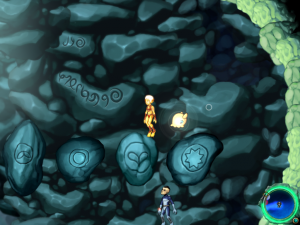WoW: Outland Described Further
I’ve done significant amounts of exploration and questing in three Outland zones now — Hellfire Peninsula, Zangarmarsh, and Terokkar Forest — and so I think it’s time to post some more possibly-misguided generalizations about what Outland is like and how it differs from Azeroth.
One way the zones of Outland emphasize that you’re not at home: color. A lot of zones in Azeroth use color themes and ambient light to suggest the quality of the atmosphere, making everything redder where the sun is fierce, or greyer where the ruins are foggy and desolate. Transitioning between zones with extreme color differences, you can actually watch the sky change. But none of the color schemes I’ve seen in Azeroth are as extreme as what I’ve seen in Outland. Zangarmarsh in particular is absurdly blue.
Outland, also known as Draenor, is the home of the Draeni, the first playable race in the game that isn’t either Tolkien-standard or animal-based. (I find them a little reminiscent of Githzerai, but I think that’s mostly because of their role in the story.) Blue of skin and blank of eye, they look a little bit Orcish and a little bit Elvish, but with the less human aspects exaggerated. The beards on the males turn out on closer inspection to be some sort of facial tentacles, and their cloven hooves remind us that they’re ultimately of the same stock as the so-called demons that lead the Burning Crusade.
Speaking of demons, remember how Warlock characters get to summon demons to fight for them? There are various sorts of summonable, including both traditional sorts like imps and succubi and less familiar things like the cloud-like Voidwalker and the weirdly spiky Felguard. In a nice touch, you can see all of these creatures roaming free for the first time in the Hellfire Peninsula. Voidwalkers don’t even seem to be affiliated with the Burning Crusade at all; they just roam the more dimensionally-unstable places going about their own business.
In short, despite being definitely in the fantasy genre, it’s still an alien planet, with alien life forms. The fact that Draeni tend to wear robes and carry swords does not change the fact that they are basically kind of sci-fi. (It’s kind of like the Marvel Comics version of Asgard sometimes.) Some of Azeroth’s monsters are pretty alien too, mind you — there are buglike creatures called Silithid that are pretty plainly modeled after the Zerg from Starcraft. But in Outland, even the plants are a bit otherworldly. The trees of Terokkar are tufted and spiky and twisted, not quite like anything on Earth. The ones in Zangarmarsh are actually enormous mushrooms, with caps large enough to land a flying mount on.
 Comments(0)
Comments(0)